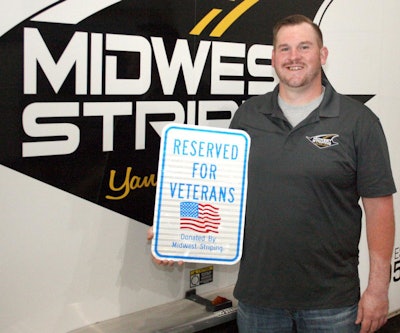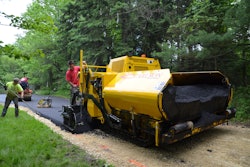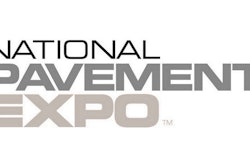
Robert Lindsay started his three-person company, Midwest Striping, in 2010 after returning from his first deployment overseas. The business, based in Yankton, SD, has grown steadily since then – but this year Midwest Striping started receiving all sorts of recognition because of an idea Lindsay had to honor military veterans.
The idea, he says, was simple: A sign designating a parking spot for military veterans or active service personnel.
“I like to give back to the community and I was thinking about what would be a good thing that we could do,” he says.
“Being as I’m in the military and I’ve been a member of my local search and rescue Dept for 15 years I thought maybe we could recognize those people somehow and I thought signage might be something that would work.”
He says he’d seen similar signs for Purple Hearts veterans but not for veterans in general or first responders.
“So I thought maybe that’s something we can do,” he says. “It’s a fairly inexpensive idea for us, and we don’t charge for it. It will be seen by a lot of people and can benefit quite a few people. I just thought that a money donation to a cause only goes so far but something like this lasts and would affect more people.”
He has had signs made honoring veterans and recently added an “everybody” sign that states,
“Super Heroes Parking. Reserved for vets, active military, law enforcement, fire, EMS and search & rescue personnel. Thank you for your service.”
Property owners can select the sign they want.
“My guess is we’ll probably end up using the ‘everybody’ sign and that’s fine,” Lindsay says. “The biggest thing is the recognition.”
Joining Up and Becoming a Striper
Lindsay says “the military runs in our family on both sides,” so he joined the Army National Guard in 2006 while he was working for an aviation firm. “My father was a Vietnam veteran and he had a lot of pride serving his country. So when I was 21 I decided it was my time to join up and serve.”
Lindsay says he enjoys serving in the Army National Guard because “you get to work your normal job and you get to do your Guard job as well.” But in 2007 the aviation company lost a major contract and Lindsay was laid off – and he didn’t like the experience. In 2007 he started a new job and in 2008 got word he was deploying. Because of the recession in 2008 people had to get laid off and he was one of them because he was leaving in a few months.
“That was the straw that broke the camel’s back,” he says. “I had been laid off before and I didn’t like it. I decided I didn’t want to work for ‘the man’ anymore and decided to start my own company.”
The question became, what kind of company to start?
The National Guard can get deployed by the state or by the federal government and Lindsay was deployed twice – in 2009-2010 spending nine months in country in Kuwait and Afghanistan and in 2016-2017 in Iraq. He had had some experience striping airports when deployed, so it was during that first deployment in 2009 that Lindsay decided to start a striping business.
“There seemed to be a really big need in our area for striping,” he says. “I had seen a lot of faded striping and some of the work I did see I just thought ‘Wow, I could do better than that with a hand roller.”
He also said there weren’t many local striping companies. “I saw guys striping around town but didn’t see a lot of them,” he says. “I also saw striping companies traveling from as much as two hours away to do work, so I figured there was opportunity there.”
When he returned from deployment in 2010 he bought a trailer and equipment without taking a business loan (he still hasn’t taken a loan in 9 years) and built on some of the small-scale striping he’d done “here and there” when he worked in aviation.
“There was a little bit of a learning curve but we stayed busy from the start and we’ve grown every year,” he says.
Today Midwest Striping has three people including his wife Cassie,his brother Dennis and part-time employee Jesse. He says 95% of their work is on parking lots with the remainder on city and county roads, city intersections, railroad crossings and game courts. In the winter Midwest Striping applies decorative floor coatings such as epoxy to concrete and plows snow.
“We’ve done a lot more work on streets the last few years because we want to move into that area,” he says. “We’ve also done some 8- to 15-mile stretches of highway work.”
He says they’ve also recently added durable markings including thermoplastic and MMA to generate more work on intersections.
“We plan to eventually do more on the durable side of things and probably buy a small truck for doing longer-line projects, but not the real big long-line work,” he says.
Interest in Installations Grows
While on his second deployment Lindsay reached out to some of his large, regular customers back home and asked them if they were interested in designating a parking space to honor military veterans. He made it clear that Midwest Striping would provide the sign and installation free of charge.
Some customers resisted because they were afraid providing a sign and parking spot for one group would open the door to other groups who would want their own parking sign, but since he began actually installing the signs this year the response has been very good.
He says he initially got some flak through social media from people who said they liked the idea but were upset because they thought the veterans signs were taking a handicap spot away from a person with disabilities. He says he's also "gotten some flak" from people including veterans thinking it's disrespectful to designate a spot because they're not better than anyone else.
“But we’re not touching those handicap spots,” Lindsay says. “These veterans’ parking spots can be wherever in the facility you can put one. Most people put them toward the front of the lot but they don’t remove any handicap spaces to do it.
“If we’re already on a site and if we think there’s a parking spot where this could work we ask them if they’d mind. We tell them we’d love to do this on their parking lot at no charge.
“It doesn’t matter where the spot is – whether it’s near the front door or in the middle of the parking lot,” Lindsay says. “We’re not trying to provide priority parking for anyone – it’s more just recognition for the people who have served to hold a spot for them. Our goal is to get as many out there as possible.”











![Lee Boy Facility 2025 17 Use[16]](https://img.forconstructionpros.com/mindful/acbm/workspaces/default/uploads/2025/09/leeboy-facility-2025-17-use16.AbONDzEzbV.jpg?ar=16%3A9&auto=format%2Ccompress&fit=crop&h=135&q=70&w=240)








